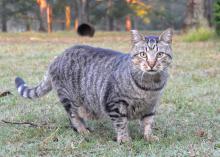Information Possibly Outdated
The information presented on this page was originally released on October 13, 2017. It may not be outdated, but please search our site for more current information. If you plan to quote or reference this information in a publication, please check with the Extension specialist or author before proceeding.
Spay or neuter cats whenever possible
STARKVILLE, Miss. -- Feral cat control has been hotly debated in recent years because of concerns over lethal measures to limit the numbers of animals many consider to be pets.
Many of us have experienced the feel-good act of feeding or housing a stray cat. With so many cats roaming freely, how can we tell if a cat is wandering, homeless or feral? Knowing the difference can allow you to take the most humane action in helping the cat.
Physically, feral cats look the same as most house cats. The easiest way to determine if a cat is feral is to observe its behavior around people. Feral cats have had little or no human contact, and they act like what we think of as a “wild” cat. They may hiss, arch their backs and run away. Stray or wandering house cats may meow, approach people cautiously and even rub against a hand or leg.
If the cat’s behavior indicates that it is feral, it is best not to try to approach or handle it. The animal may bite and carry diseases. If feral cats are congregating in an area and causing a nuisance, it is best to contact local animal control officers to help mitigate the problem.
Even though feral cats avoid human contact, their preferred habitat is in heavily populated urban and suburban areas. Feral cats often take shelter in abandoned buildings, barns, culverts or junked cars, living in colonies of up to 100 animals or more. These large groups have displaced native urban predators such as raccoons, foxes and coyotes in some areas by competing for the same prey animals.
The millions of feral cats in the U.S. also have a tremendous direct impact on song bird, game bird, rodent and rabbit populations, consuming tens of millions of these animals each year, according research conducted by the University of Wisconsin. Since female feral cats can breed before the age of 6 months and can produce up to 30 kittens per year, populations can easily contaminate an area with urine and feces, as well as become a reservoir for diseases that affect wildlife and humans.
Cat ownership laws vary from state to state, but in most municipalities, a cat without identification is considered stray or ownership is delegated to the owner of the property where the cat lives. Control of feral cats is a sensitive topic because many people consider them pets and not wildlife.
One popular method to control feral cat populations is to trap them for spaying/neutering and later release. Trap-neuter-return cats typically have a small piece of one ear snipped for future reference. Animal control officers suggest allowing trained experts to live trap feral cats due to the risks of being bitten.
Once spayed or neutered, feral cats are available for adoption at very low rates because they are difficult to tame. Lethal control methods for feral cats are sometimes necessary to regulate exploding populations that threaten human health, pets, wildlife and even livestock such as chickens.
The most effective method for reducing feral cat populations is to practice responsible pet ownership by adopting only animals that you have time and money to care for and by ensuring that each cat is spayed or neutered.

Editor’s Note: Extension Outdoors is a column authored by several different experts in the Mississippi State University Extension Service.








